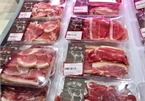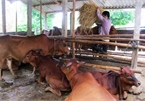However, since last year, this price has increased by 25-30%. So have the prices of animal feed. Meanwhile, prices of beef at restaurants and hotels have dropped due to weaker demand. The situation paints a gloomy picture of the industry.
 |
| A herd of beef cattle in Vietnam. – SGT Photo: H.P |
In 2014, Hoang Anh Gia Lai Group announced its large-scale beef cattle farming plan, an ambitious one, to raise hundreds of thousands of cattle heads for domestic consumption. However, the group’s scheme was soon shelved afterward as business results fell short of expectations.
What the Vietnamese beef cattle industry does is that, in fact, it carries out a phase in the husbandry chain. Vietnamese beef cattle raisers import cattle weighing at least 300 kilograms per head to fatten them during 100-200 days to lift their weight to 480-500 kilograms. Finally, the cattle are sent to slaughterhouses for beef. Several of them may reach 1 ton in weight. The enterprise in question will benefit the weight increase.
The company in charge of beef cattle of Hoa Phat Group, whose main scope of business is steel making, is currently the largest entity in this industry in Vietnam. Their extensive farms meeting Australian standards in this regard are in Thai Binh and Quang Ninh in the north and Dong Nai in the south. The firm’s bovine herds, some 10,000 heads in 2016 have soared to 140,000 after five years. Hoa Phat has done business in this industry in line with the spillover effect: it builds ranches, raises cattle, meets its customers and seals deals. Highly competitive, Hoa Phat has taken market shares of its predecessors in a beef market whose growth rate is estimated at 7% annually.
Digitalization in the beef cattle industry
The raising process of beef cattle is closely related to biological safety, food hygiene and supplies of materials for animal feed production, such as cassava chips, dried palm, dried coconut, dried soybean, and molasses from sugar production. In addition, there must be corn kernels and maize stalks. Beef cattle raising businesses often work with farmers to ensure the supplies of green feed.
At some leading beef cattle companies, the raising process is in line with Australian ESCAS (Exporter Supply Chain Assurance System). This system ensures the right of cattle “to be slaughtered humanely.”
In Vietnam, the slaughtering process used to be carried out manually making use of hammers. However, stunners, or captive bolt pistols, are now available at modern abattoirs.
In Australia, a special department is in charge of monitoring “the right of being slaughtered humanely” of food animals, including cattle. The personnel of this department install cameras at slaughterhouses. Also, along with cattle tracking systems, each cattle head exported by Australia is fixed with a GPS ear tag and a chip.
When an Australian cattle head arrives at the destination, the Australian side has all the data at the new place. When the bovine is sold, data about it are recorded. The Australian side tracks their exported cattle at slaughterhouses. At some abattoirs in Vietnam, there are cameras fixed and a person from the Australian company responsible for ensuring the cattle would be decently treated before being slaughtered. A cattle head must be dead during a certain amount of time. If the time limit is violated, those involved will be warned. There is an Australian office in Indonesia which monitors what happens to Australian cattle shipped to importing countries in the region. When a cattle head is slaughtered, the chip fixed to it will alert the office accompanied by the images of the slaughtering process. All is digitalized.
The above digital process of beef cattle is complicated and costly. However, it is worthwhile because Vietnamese cattle buyers can manage every individual they buy.
Beef cattle business a hard endeavor
A problem here in Vietnam is that not all Vietnamese raisers of Australian beef cattle abide by ESCAS regulations. As some traders in the north choose to buy Australian beef cattle at high prices, several firms that own the cattle cut the bovines’ ears and deactivated the chips to sell them to the traders. But this caused the Australian side to fail to record their cattle, and the local firms involved would later be banned from importing Australian beef cattle.
“All our customers eligible for buying Australian beef cattle are ratified by the Australian side,” said a representative from Hoa Phat Group. “Players in the game must be competitive. Weaker ones will be eliminated and lose their market shares. To survive, one must comply with the rules.”
Vietnamese beef cattle raisers import between 200,000 and 300,000 Australian bovines a year at a price of VND38-45 million per head (US$1,650-1,950). Aside from Australian cows and oxen, Vietnamese importers are on the verge of importing cattle from Brazil to diversify their sources of supplies. This news came after officials from the Vietnamese Ministry of Agriculture and Rural Development had worked with the Brazilian authorities to prepare for the signing of a bilateral treaty on veterinary issues and bilateral trade.
Vietnam’s beef supplies are abundant. Australian cows and oxen account for some 30% of the market share. About 200,000 heads of beef cattle are brought to Vietnam every year from Thailand via border gates. Some of the bovines for meat in Vietnam come from Cambodia and Myanmar totaling approximately 300,000 head per year.
There are remarkable supplies from local farmers, too. However, accurate statistics remain a conundrum because local farmers do not have the habit of reporting what they raise. The State has recently announced its strong support for farmers who raise beef cattle. However, although the herds of bovines in Vietnam have increased quantitatively, they are mostly in small scale.
In the pre-Covid-19 period, Vietnam consumed 1,500 bovines a day, which has been cut by a half. That is partly because cheaper buffalo meat from India is so competitive, partly because poultry prices have become lower prompting consumers to switch to using the latter.
Another rescue of local beef?
Local beef cattle raising enterprises are too many to be listed all here. In the heyday, from five to seven years ago, their profit margin might amount to between 20% and 30%. However, animal husbandry needs a long-term vision. Some entrepreneurs deemed this industry a lucrative business and rushed to engage in it. Yet the reality is a different story. Cheap meat from imported buffaloes and poultry has added fuel to the fire. Prices of feed and breeds have risen, but beef cattle raising firms are unable to lift their prices correspondingly, resulting in a smaller profit margin.
There are “waves” in the business of agricultural products and animal husbandry, too. When meat prices soar, people keep pouring investment in breeds and farms. Yet as soon as supply increases exponentially and demand fails to catch up with them, prices will plummet. That cycle has happened time and again, indefinitely. The survivors in this regard are enterprises with strong financial backing and capable of using profit to offset losses. To those that cannot manage well their investment, raising cattle or any kind of food animals can become a failure in the end.
Vietnamese have attempted several rescues of agricultural products, such as vegetables and fruits. Hopefully, no rescue effort will be made for domestic beef.
SGT

Imported beef grabs 70% of market share
Vietnam imported 70 percent of its beef this year, with domestic beef accounting for only 30 percent of the market.

Vietnam to develop cattle breeding, say officials
Vietnam’s agricultural sector will focus on developing cattle, poultry and aquatic breeding to compensate for a shortage of pork which is expected...